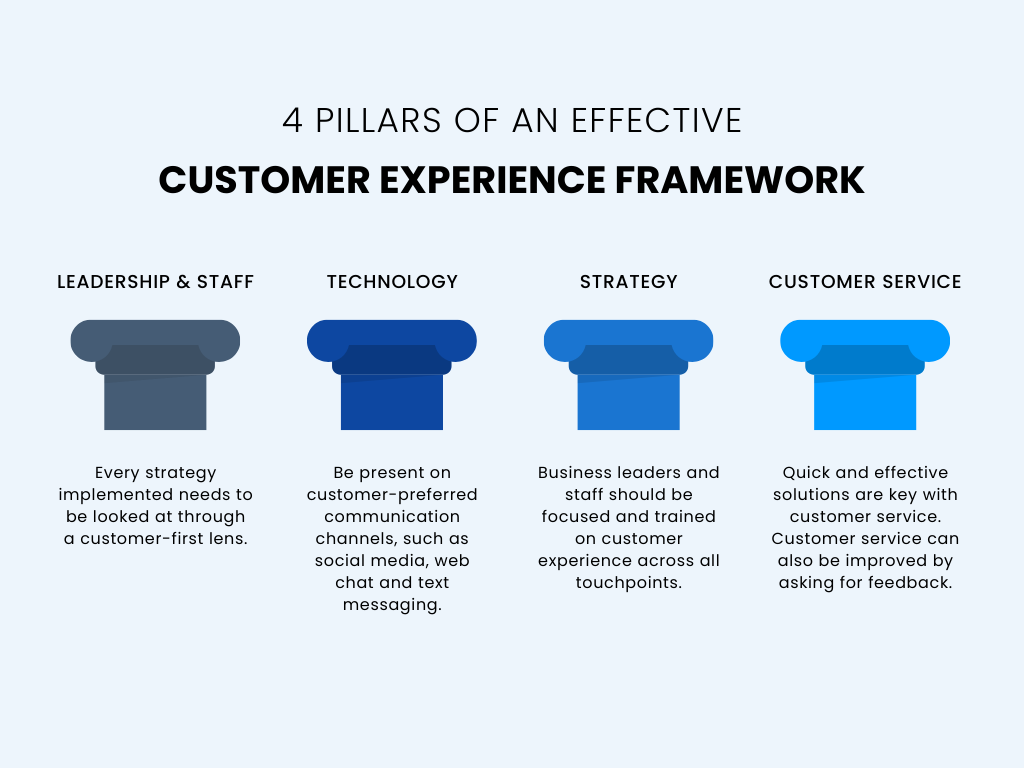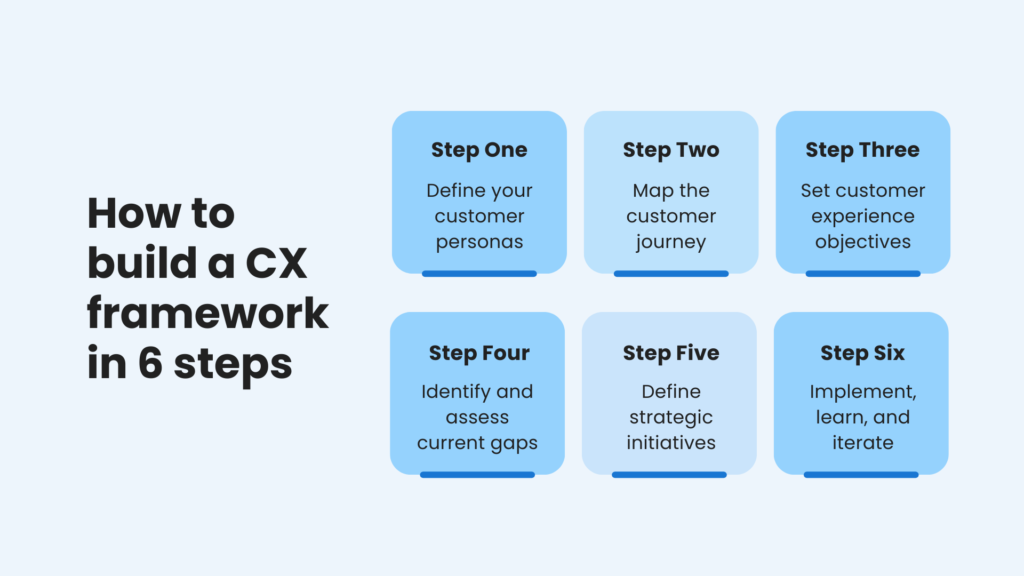Nowadays, business success hinges on customer experience. In fact, according to Birdeye data, 67% of consumers tell family and friends about their negative experiences, and 62% switch to a competitor. In other words, if you can’t keep customers happy, you’re going to lose them.
Happy customers are a result of many factors — exceptional products, stellar communication, and good customer experience, just to name a few. And good customer experience doesn’t happen by accident. So, how do you create a fantastic customer experience for your business? Learn how to get started with an all-encompassing and thorough customer experience framework through these best practices.
Customer service and customer experience actually is marketing, you just have to first think of it as such — Customer experience expert, Jay Baer
What is a customer experience framework?
The customer experience framework is a set of tools and procedures that businesses put in place to ensure exceptional CX. But as Harvard Business Review (HBR) points out, “Many companies don’t intentionally plan their customer experiences.” HBR also explains that most customer relationship management initiatives of businesses are focused on making internal processes easier and are profit-driven, but are not really focused on the customer.
“This mindset is perfectly illustrated by the most common CRM objectives: increase sales, drive cross-selling, minimize resources, reduce ancillary expenses, and lower the number of costly channel interactions. Those objectives indicate an inside-out view that implicitly treats the processes and internal metrics as more important than the customer.” – Harvard Business Review
By focusing on customer service alone, you cannot guarantee a good customer experience. Customer service is only one piece of the puzzle. CX sits at the intersection of design, product value, brand, customer interactions and transactions, marketing, and communication strategy. You have happy and loyal customers when all these departments work together well. This is why having a strong customer experience framework is important.
What are the 4 pillars of a good customer experience framework?
There are four main pillars of a good customer experience framework. All four are important and must work well together for a framework that consistently delivers a good customer experience. Let’s get into it.

1. Strategy
Whether it is marketing strategy, understanding the voice of the customer for good feedback, or other business strategies, every strategy implemented needs to be looked at through a customer-first lens.
2. Technology
Effortless and timely communication with customers, both customer-led and business-led, is key to good customer experience. Be sure to be present on customer-preferred communication channels, such as social media, website chat and text messaging. These channels need to be run well too, with frequent posting, high-response rate and good visibility. Another factor that promotes a good customer experience is optimization for mobile. If your website doesn’t read well on mobile, it’s going to drive customers away.
3. Leadership and staff
Business leaders should be focused on Customer Experience across all touchpoints. This should be communicated well with staff and employees across departments to train them to focus on providing exceptional CX as well.
4. Customer service
Customer service isn’t just for tech giants such as Amazon or Uber. Every business needs a good relationship with their customers to ensure their success. Imagine this, you are an electronics company and a customer bought a laptop that had dead pixels in the screen. How would you handle this? For the best customer service, the company should respond quickly by replacing the defective item free of charge. Quick and effective solutions are key with customer service. This way the customer isn’t discouraged from doing business with you in the future. Customer service can also be improved by asking for feedback. Surveys are a great way to get actionable insights and feedback from the customers to make improvements to existing processes.
Best practices to create a good customer experience framework
It can be challenging to create a successful customer experience framework. Let’s start by discussing some best practices that can act as guidelines.
1. Think from the customer’s point of view
A good CX is one which is always focused on the customer. While this might sound obvious, what businesses fail to understand is that all internal processes and decisions affect the customer. Customers aren’t just simply affected by the end result, because the end result is a product of all the decision-making processes.
Businesses make the mistake of changing processes to suit the internal agenda, which often does not take the customer into consideration. This can be avoided by thinking about all decisions from the customer’s point of view.
For example, if Jenny’s auto repair shop decides to postpone redesigning their old website to next year, this affects CX. If the website is hard to use, not mobile-friendly, or doesn’t have enough information, it doesn’t encourage customers to visit the website. This is bad CX.
2. Work with all departments
It is not just something the Customer Success Department or Chief Customer officer needs to think about. Every department within the business, including leadership, needs to focus on the customer.
"Great customer experience is intentional, purposeful and consistent." -- Diane Magers, CEO and chairman of the board of the Customer Experience Professionals Association
A customer experience framework that runs across all the departments within the business helps make CX intentional, purposeful and consistent and not just transaction-focused.
For example, in a dental practice, all departments work together to create a CX that is exceptional across all touchpoints. Dentists need to focus on providing high-quality patient care, the front desk needs to focus on processes that promote easy appointments, and the janitor and cleaning staff need to focus on excellent hygiene. By keeping the potential patient in mind, your dental practice will act in a way that benefits your patient or customer. This is good CX.
3. Constant tuning to better existing processes
If you have a good customer experience framework in place, the work doesn’t end there. Best customer relationship management practices continuously evolve, and your framework should also follow suit.
This constant tuning should also happen across all departments, from product development to marketing. Trusting and learning from departments that are constantly engaging with customers can help here. For example, if you are a law firm, where the front desk attendant gets at least two comments a day from clients about website chat availability while making appointments. The law firm needs to listen to these comments and gather feedback from the front desk attendant. If the feedback is that website chat will make your law firm’s client experience better, you should act on it.
4. Stellar customer experience, no matter what
Customers are likely contacting you through various communication channels including email, SMS texting, webchat, and Facebook Messenger. Instead of overextending your staff and becoming overwhelmed, get a customer interaction management system that integrates all of these communications into one unified inbox. Now your employees don’t need to waste time sorting through messages in every single channel, and the quality of responses can be monitored in one location. Unified inboxes make it easier than ever to respond quickly and keep track of your customer communications. Never miss another message again! With a customer interaction management system, you can deliver high-quality customer experience across all channels.
How to build a CX framework in 6 steps
Next, let’s break it down into actionable steps. Follow steps below to build a robust CX framework:

1. Define your customer personas
Start by researching your existing customers as well as your target audience to define 2-3 primary customer personas. Develop an in-depth understanding of these persona’s wants, needs, behaviors and pain points when engaging with your industry. Avoid making assumptions and base these personas on your most loyal customers.
2. Map the customer journey
Next, map out the end-to-end journey each persona goes through when interacting with your company. Identify key phases and touchpoints, from initial brand awareness through purchase and long-term engagement. You may have different journeys for prospect customers vs. existing customers.
“Customer experience is a collection of touchpoints along the buyer journey. Whether you’re buying a car, visiting a doctor, or you need a new roof, there are so many interactions between the consumer and the business.” Naveen Gupta, CEO of Birdeye
3. Set CX objectives
Now set clear objectives for the experience you aim to deliver at each touchpoint and overall. This includes emotional elements like fostering trust or excitement as well as functional aims like simplifying purchases. Ensure executive leadership supports these goals.
4. Identify and assess current gaps
Compare your objectives to current reality by gathering customer feedback through surveys, interviews etc. Look for gaps where you are falling short on expectations around ease, service, emotional connection and other pillars.
5. Define strategic initiatives
Based on the gaps uncovered, definetargeted initiatives to elevate customer interactions. This roadmap should address priorities across channels, processes, technologies, content, staffing and more. Focus on changes that maximize impact.
6. Implement, learn, and iterate
Finally, implement your CX plan, starting with the highest priority efforts. Make sure to continuously gather feedback to gauge progress and rapidly iterate to optimize the experience. Remember: CX is never “complete.” You must evolve as you learn.
Customer experience framework FAQs
A customer experience framework is used to optimize interactions between a business and its customers, focusing on improving customer satisfaction, loyalty, and overall engagement through a structured and systematic approach.
The formula for a CX score often involves metrics like Net Promoter Score (NPS), Customer Satisfaction Score (CSAT), and Customer Effort Score (CES). A common approach is to calculate these scores based on customer survey responses and then aggregate or compare them to gauge overall CX performance. However, the specific formula can vary based on the organization’s chosen metrics and methodologies.
The three phases of customer experience typically include:
Discovery phase: Where customers become aware of a product or service.
Purchase phase: The actual transaction or acquisition of the product or service.
Post-purchase phase: The ongoing experience after the purchase, including customer service, support, and potential repeat purchases.
These phases help in understanding the customer journey from initial awareness to long-term loyalty.
How can Birdeye help
Birdeye is an all-in-one experience marketing platform that has all the tools you need to establish a good customer service framework. Businesses can use tools such as website chat, surveys, text messaging, including bulk text messaging to improve their customer experience management and customer service. Find out how Birdeye can help you create the best customer experience framework for your business.

Originally published









